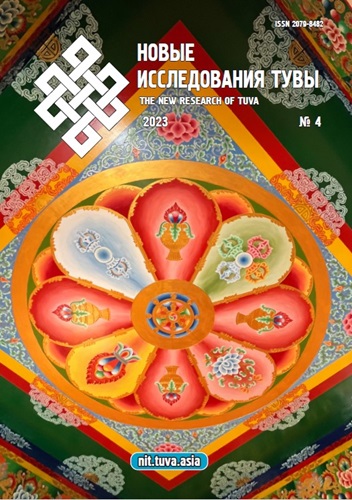Tuva tourist: linguistic and cultural features of marketing Internet communication
DOI:
https://doi.org/10.25178/nit.2023.4.14Keywords:
Tuvans; Tuva; Tuva image; tourist brand; linguaculturology; Tuvan culture; linguistic constructAbstract
The article critically examines the issue of linguacultural specificity within the domain of marketing internet communication, focusing on materials sourced from Russian-language websites and the YouTube video hosting platform dedicated to tourism in the Republic of Tuva. The study delineates how the regional culture intricately shapes the selection of linguistic tools for crafting a compelling Tuva brand tailored for potential audiences in online promotional endeavors.
Various linguistic constructs actively contribute to the representation of the Tuva brand, with particular emphasis placed on the efficacy of epithets and phraseological units. Tuva is portrayed as a distinctive tourist brand, characterized as a “unique land”, a “land of contrasts”, a “place of power”, a “land of living traditions”, among other epithets. Special attention is directed towards the portrayal of Kyzyl, the regional capital, which is depicted based on local landmarks (Cechenling Temple, the Center of Asia obelisk, the Aldan-Maadyr National Museum, etc.), hospitality establishments (hotels), and indigenous souvenirs encompassing elements of the Tuvan costume, utensils, home goods, and smoking pipes. Noteworthy is the development of proprietary brands in Tuva, such as the “Devig” clothing brand, the “Vaviol” company (“Herbs of Tuva”), Brand Dongak, and others. The Tuvinian national cuisine is also a focal point, with frequent references in online communication to gastronomic brands in the region bearing Tuvan names: suttug shai, khymys, araga, buuza, khuzhur, manchyyr, and others.
The linguacultural specificity of tourism websites in the Republic of Tuva lies in the presentation of a unique regional image that encapsulates information on diverse forms of tourism, including spiritual, sports, health-oriented, ecological, cultural-cognitive, and more. This multifaceted representation is conveyed through specific figurative linguistic means, notably tropes and phraseological units.
Depending on the chosen destination, each traveler has the opportunity to explore the natural landscape diversity of the region and gain an appreciation for the unique authenticity of its culture.
References
Alefirenko, N. F. (2010) Lingvokul'turologiia: tsennostno-smyslovoe prostranstvo iazyka [Linguoculturology: Value-semantic space of language] : A study guide. Moscow, Flinta; Nauka. 224 p. (In Russ.).
Arakchaa, L. K. (2019) Sviashchennaia Tuva [Sacred Tuva]. Kyzyl, TuvGU. 190 p. (In Russ.).
Biche-ool, T. N. and Dongak, K. Kh. (2021) Turizm Respubliki Tyva: razvitie, territorial'nyi potentsial [Tourism of the Republic of Tyva: development, territorial potential]. Vestnik Tuvinskogo gosudarstvennogo universiteta. Estestvennye i sel'skokhoziaistvennye nauki, no. 4 (85), pp. 48–55. (In Russ.).
Borisova, E. G. (2020) Chto daet marketingovaia lingvistika marketingu i lingvistike? (vmesto predisloviia) [What does marketing linguistics give to marketing and linguistics? (instead of a preface)]. In: Marketingovaia lingvistika. Zakonomernosti prodvigaiushchego teksta [Marketing linguistics. Patterns of the promoting text] / ed. by E. G. Borisova and L. G. Vikulovoi. Moscow, FLINTA. 164 p. Pp. 4–11. (In Russ.).
Weinstein, S. I. (2016) Zagadochnaia Tuva [The mysterious Tuva]. Moscow, Domashniaia gazeta Publ. 416 p. (In Russ.)
Vedenin, Yu. A. (2018) Geografiia naslediia. Territorial'nye podkhody k izucheniiu i sokhraneniiu naslediia [Geography of heritage. Territorial approaches to the study and preservation of heritage]. Moscow, Novyi Khronograf. 472 p. (In Russ.).
Ivanov, E. E., Lomakina, O. V. and Nelyubova, N. Yu. (2021) Semanticheskii analiz tuvinskikh poslovits: modeli, obrazy, poniatiia (na evropeiskom paremiologicheskom fone) [Semantic analysis of Tuvan proverbs: models, imagery, concepts (against the European paremiological background)]. New Research of Tuva, no. 3, pp. 232–248. (In Russ.). DOI: https://doi.org/10.25178/nit.2021.3.17
Kir'ianova, L. G. (2022) Marketing i brending turistskikh destinatsii [Marketing and branding of tourist destinations]. Moscow, Yurait. 264 p. (In Russ.).
Kolokol'tseva, T. N. (2018) Predislovie [Introduction]. In: Internet-kommunikatsiia kak novaia rechevaia formatsiia [Internet communication as a new speech formation] / ed. by T. N. Kolokol'tseva and O. V. Lutovinova. Moscow, FLINTA, Nauka. 328 p. Pp. 5–9. (In Russ.).
Komarov, M. A. (2020) Marketingovye kommunikatsii v prodvizhenii territorial'nogo brenda [Marketing communications in the promotion of a territorial brand]. Regional'naia ekonomika: teoriia i praktika, vol. 18, no. 10 (481), pp. 2001–2018. (In Russ.).
Kuzhuget, A. A. (2012) Perspektivy tuvinskoi «Vikipedii» [Prospects of the Tuvan Wikipedia]. New Research of Tuva, no. 2, pp. 142–145. (In Russ.).
Kusmidinova, M. Kh. (2015) Formirovanie kontsepta reki v russkoi kul'ture na primere Volgi [Formation of the river concept in Russian culture on the example of the Volga]. Teoriia i praktika obshchestvennogo razvitiia, no. 21, pp. 205–208. (In Russ.).
Lamazhaa, Ch. K. (2018) Natsional'nyi kharakter tuvintsev [National character of Tuvans]. Moscow; St. Petersburg, Nestor-Istoriia. 240 p. (In Russ.).
Lamazhaa, Ch. K. and Suzukei, V. Iu. (2019) Tuvinskoe gorlovoe penie kak nematerial'noe kul'turnoe nasledie i kak kul'turnyi brend Tuvy [Tuvan throat singing as intangible cultural heritage and as Tuva’s cultural brand]. New Research of Tuva, no. 2, pp. 72–83. (In Russ.). DOI: https://doi.org/10.25178/nit.2019.2.6
Lomakina, O. V. (2022) Tuvinskaia paremiologiia: lingvokul'turologicheskii i lingvoaksiologicheskii potentsial [Tuvan paremiology: its linguoculturological and linguoaxiological potential]. New Research of Tuva, no. 1, pp. 6–16. (In Russ.). DOI: https://doi.org/10.25178/nit.2022.1.1
Malysheva, E. O. (2020) Etnokul'turnyi turizm v turistskoi destinatsii (na primere Respubliki Tyva) [Ethno-cultural tourism in a tourist destination (on the example of the Republic of Tyva)]. Servis+, no. 3, pp. 31–37. (In Russ.).
Mukhar'iamova, L. M. (2003) Iazykovoĭ marketing: napravleniia strategii planirovaniia [Language marketing: directions of the planning strategy]. Gosudarstvennaia sluzhba, no. 6, pp. 64–73. (In Russ.).
Neliubova, N. Yu. (2022) Aksiologicheskie dominanty paremii kak tipologicheskie markery tuvinskoi, russkoi i frantsuzskoi etnokul'tur [Axiological dominants of paremies as typological markers in Russian, Tuvan and French ethnic cultures]. New Research of Tuva, no. 1, pp. 146–163 (In Russ.). DOI: https://doi.org/10.25178/nit.2022.1.10
Printsev, I. (2011) Raduga Tuvy [Rainbow of Tuva]. New Research of Tuva, no. 2–3, pp. 305–307. (In Russ.).
Peemot, V. V. (2012) Tuvinskii proekt finskogo Nomad-tsentra [Tuva project of the Finnish Nomad Center]. New Research of Tuva, no. 4 (16), pp. 207–209. (In Russ.).
Sereedar, N. Ch. (2018) Tuvinskii iazyk kak sredstvo obshcheniia tuvintsev: problemy i perspektivy [Tuvan language as means of communication among Tuvans: Problems and prospects]. New Research of Tuva, no. 1, pp. 4–19. (In Russ.). DOI: https://doi.org/10.25178/nit.2018.1.1
Teliia, V. N. (1996) Russkaia frazeologiia. Semanticheskii, pragmaticheskii i lingvokul'turologicheskii aspekty [Russian phraseology. Semantic, pragmatic and linguoculturological aspects]. Moscow, Yazyki slavianskoi kul'tury. 288 s. (In Russ.).
Tsybenova, Ch. S. (2018) Funktsionirovanie tuvinskogo iazyka v razlichnykh kommunikativnykh sferakh [Functioning of the Tuvan language in various communicative spheres]. Tehlikedeki Diller Dergisi / Journal of Endangered Languages, no. 13, pp. 83–90. (In Russ.).
Baker, C. and Jones, S. P. (1998) Language Marketing. In: Baker, C., Jones, S. P. Encyclopedia of Bilingualism and Bilingual Education. Clevedon, Philadelphia, Toronto, Johannesburg. 758 p. Pp. 221–228.
Published
How to Cite
For citation:
Sknarev D. S., Rusakova M. M. and Nelyubova N. Yu. Tuva turisticheskaia: lingvokul’turologicheskie osobennosti marketingovoi internet-kommunikatsii [Tuva tourist: linguistic and cultural features of marketing Internet communication]. New Research of Tuva, 2023, no. 4, pp. 200-216. DOI: https://doi.org/10.25178/nit.2023.4.14
Issue
Section

This work is licensed under a Creative Commons Attribution-NonCommercial 4.0 International License.

Author(s) license holder(s) grant rights for their work to the journal (grantee of a license) under the simple non-exclusive open license in accordance with Art. 1286.1 «Open license for a research work, work of literature or fine arts», Civil Code of the Russian Federation.
New Research of Tuva publishes articles under the Creative Commons Attribution-NonCommercial license (CC BY-NC).
Since it is an open license, author(s) reserve the right to upload the article to their institutional repository, submit it to another journal (if it allows republications), or republish it on their own website (in full, or in part).
However, several conditions apply here:
a) The republished version must always contain the name(s) and affiliation(s) of the author(s), the original title and the hyperlink to the original version on the New Research of Tuva website;
b) It must be in open access, free of charge, and no category of readers must be in any way whatsoever advantaged over general readership.
c) should the contribution be submitted elsewhere by its author(s) without substantial modification (30% or more of original text unchanged), the body of the article should contain a disclaimer that the original version was published in New Research of Tuva (with a link to the respective page)
The CC-BY-NC is a non-revocable license which applies worldwide and lasts for the duration of the work’s copyright.











